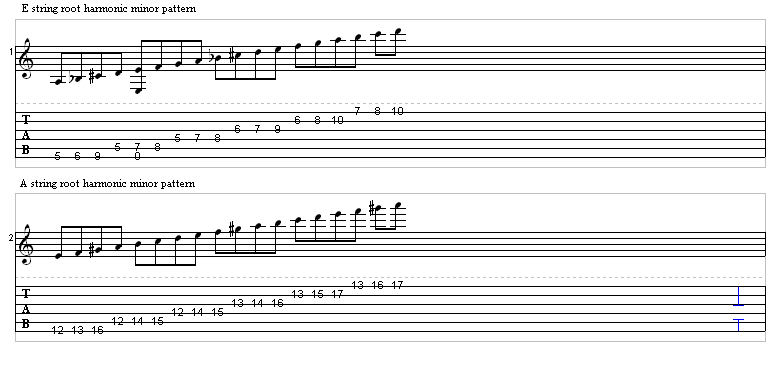Over the course of your life as a guitar player you hear about all sorts of wild exotic scales that you are sure you will never use. Hungarian minor, altered hexatonic scales, dominant diminished, whole tone, major lydian pentatonic, each one more obscure than the last. But if you are a rock/metal guitarist you have no doubt been intrigued by harmonic minor. It's all the rage with some of our most revered players like Yngwie, Vai, Satch, Paul Gilbert, and Rusty Cooley. What is all the fuss about? Read on.
The harmonic minor scale is a scale that is derived by taking a natural minor scale and raising the seventh degree. I will include a scale formula chart later to show you exactly the difference, but suffice it to say that if you took an A minor scale and raised the seventh step G to a G# you will have a harmonic minor scale. The scale would then become: (A, B, C, D, E, F, G#, A). Only slight modification to the existing natural minor scale patterns is necessary to have usable shapes quickly. This of course is only step one.
I hate to generalize how any scale is applied because someone with a great ear and imagination can always find new ways to use any scale, but here are the general ways harmonic minor is applied. It can be used over; any simple minor triad chord, a minor (major seventh) chord, a minor power chord progression that raises the seventh chord, riffs derived from the harmonic minor scale, and a dominant V chord in a minor key. The usefulness of this scale is not limited to these examples however, because much like the diatonic scale, harmonic minor contains seven modes.
1st mode - Harmonic Minor (1, 2, b3, 4, 5, b6, 7)
2nd mode - Locrian natural 6 (1, b2, b3, 4, b5, 6, b7)
3rd mode - Ionian #5 (1, 2, 3, 4, #5, 6, 7)
4th mode - Dorian#4 (1, 2, b3, #4, 5, 6, b7)
5th mode - Phrygian Dominant (1, b2, 3, 4, 5, b6, b7)
6th mode - Lydian #2 (1, #2, 3, #4, 5, 6, 7)
7th mode - Altered bb7 (1, b2, #2, 3, b5, #5, bb7)
In order to build the modes of harmonic minor you can use the formulas above to alter the major scale to build the desired scale. You can also start from different steps of the harmonic minor scale. For instance, if you built an A harmonic minor scale and started on the second step B and continued through the scale (B, C, D, E, F, G#, A, B) you would have a B locrian natural 6 scale. If you started on the fifth step E and played through the scale (E, F, G#, A, B, C, D, E) you would have the coolest scale ever the phrygian dominant scale. You can use the same method with any of the harmonic minor modes.
In order to know where any of these modes can work you need to understand your chord theory. Broadly speaking you can use these modes over any chord that contains or at least doesn't conflict with the basic chord tones found in the scale (1, 3, 5, 7 etc.) so if I wanted to use a mode of harmonic minor over a dominant seventh chord(1, 3, 5, b7) I would check and see which mode it doesn't conflict with. The only mode with the requisite major third and flatted seventh is the phrygian dominant mode. If I want to play over a major triad (1, 3, 5) I would find that the only one I can use is the lydian #2 scale. All of the other modes work the same way and if you want a challenge you can look at each modes chord tones and see what chords suit them.
Remember that you never have to use an exotic scale like harmonic minor or its modes. Anything can work no matter how simple it is, and just because something is complicated that doesn't mean its better. But try to think of these scales as colors much like a painter would have on his palette. The more colors you have to work with the more expressive you can be. If any of you are unfamiliar with some of the chord theory I discussed in this article please check out the lessons page of my website; www.scottallenproject.com where you can get more information. Look below to see some examples of the harmonic minor scale to get you started, but remember that if you just modify the existing minor scale patterns you will quickly have command of the entire neck.

Good luck, and have fun!
Scott Allen is a 1996 graduate of the Musician's Institute, G.I.T. He currently teaches guitar to 65 to 70 students weekly at Northridge Music Center.
His latest CD is entitled "III", featuring his impressively fluid playing, with a style marked by an incendiary sense of phrasing.